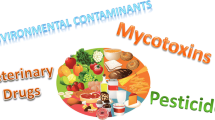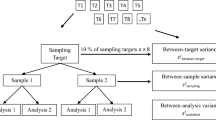Abstract
Accurate analytical results with known uncertainty are required for the safety assessment of pesticides and testing the conformity of marketed food and feed with the maximum residue limits. The available information on various sources of errors was examined with special emphasis to those which may remain unaccounted for based on the current practice of many laboratories. The method validation typically covers the steps of the pesticide residue determination from the extraction of spiked samples to the instrumental determination, which contribute to only 10–40% of total variance of results. Though the variability of sampling, sample size reduction and sample processing may amount to the 60–90% of total variance, it generally remains unnoticed leading to wrong decisions. Another important source of gross error is the mismatch of the residues analysed and those included in the relevant residue definition. Procedures which may be applied for eliminating or reducing the errors are discussed.


Similar content being viewed by others
References
Food and Agriculture Organisation (2009) FAO manual on the submission and evaluation of pesticide residues data for the estimation of maximum residue levels in food and feed, 2nd edn. 124–130. Food and Agriculture Organisation, Rome http://www.fao.org/fileadmin/templates/agphome/documents/Pests_Pesticides/JMPR/FAO_manual2nded_Oct07.pdf. Accessed 14 Aug 2010
WHO (2003) GEMS/food regional diets. Regional per capita consumption of raw and semi-processed agricultural commodities—revision September 2003. Food Safety Department. Geneva. http://www.who.int/foodsafety/chem/gems/en/index1.html. Accessed 14 Aug 2010
Food and Agriculture Organisation (2009) FAO manual on the submission and evaluation of pesticide residues data for the estimation of maximum residue levels in food and feed 2nd ed. 74. Food and Agriculture Organisation, Rome http://www.fao.org/fileadmin/templates/agphome/documents/Pests_Pesticides/JMPR/FAO_manual2nded_Oct07.pdf. Accessed 14 Aug 2010
Codex Secretariat (2002) Recommended methods of sampling for the determination of pesticide residues for compliance with MRLs. http://www.codexalimentarius.net/download/standards/361/CXG_033e.pdf. Accessed 14 Aug 2010
Official Journal of the European Communities (2002) COMMISSION DIRECTIVE 2002/63/EC of 11 July 2002 Establishing community methods of sampling for the official control of pesticide residues in and on products of plant and animal origin and repealing Directive 79/700/EEC. Off J Eur Communities 187: 30–43 http://eur-lex.europa.eu/LexUriServ/LexUriServ.do?uri=OJ:L:2002:187:0030:0043:EN:PDF. Accessed 14 Aug 2010
European Food Safety Authority (2008) 2008 Annual report on pesticide residues according to Article 32 of Regulation (EC) No 396/2005. http://www.efsa.europa.eu/en/scdocs/doc/1646.pdf. Accessed 14 Aug 2010
Kmellar B, Fodor P, Pareja L, Ferrer C, Martinez-Uroz MA, Valverde A, Fernandez-Alba AR (2008) Validation and uncertainty study of a comprehensive list of 160 pesticide residues in multi-class vegetables by liquid chromatography–tandem mass spectrometry. J Chromatogr A 1215:37–50
Pihlström T, Blomkvist G, Friman P, Pagard U, Österdahl B-G (2007) Analysis of pesticide residues in fruit and vegetables with ethyl acetate extraction using gas and liquid chromatography with tandem mass spectrometric detection. Anal Bioanal Chem 389:1773–1789
European Committee for Standardization (2008) Foods of plant origin—determination of pesticide residues using GC-MS and/or LC-MS/MS following acetonitrile extraction/partitioning and clean-up by dispersive SPE -QUEChERS-method EN 15662
Codex Alimentarius Commission (2003) Guidelines on good laboratory practice in residue analysis CAC/GL 40-1993, Rev 1-2003. http://www.codexalimentarius.net/download/standards/378/cxg_040e.pdf. Accessed 14 Aug 2010
European Commission (2010) Method validation and quality control procedures for pesticide residues analysis in food and feed, Document No. SANCO/10684/2009. http://ec.europa.eu/food/plant/protection/resources/qualcontrol_en.pdf. Accessed 14 Aug 2010
Banerjee K, Oulkar DP, Patil SB, Jadhav MR, Dasgupta S, Patil SH, Bal S, Adsule PG (2009) Multiresidue determination and uncertainty analysis of 87 pesticides in mango by liquid chromatography-tandem mass spectrometry. J Agric Food Chem 57:4068–4078
Tiryaki O, Baysoyu D (2008) Estimation of the efficiencies and uncertainties of the extraction and cleanup steps of pesticide residue determination in cucumber using 14C-carbaryl. Accred Qual Assur 13:91–99
Bettencourt da Silva RJN, Santos JR, Filomena M, Camões GFC (2003) Evaluation of the analytical method performance for incurred samples. Anal Chim Acta 485:241–252
Lykken L, Mitchell LE, Woogerd SM (1957) Sampling crops for residue analysis. J Agric Food Chem 5:501–505
Taylor AW, Freeman HP, Edwards WM (1971) Sample variability and the measurement of dieldrin content of a soil in the field. J Agr Food Chem 19:832–836
Earl M, Kaethner M, Uihlein M (2000) Unit to unit variation of pesticide residues options for acute dietary risk assessment. Food Addit Contam 17:583–589
Lentza-Rizos C, Balokas A (2001) Residue levels of chlorpropham in individual tubers and composite samples of postharvest-treated potatoes. J Agric Food Chem 49:710–714
Ambrus Á (2006) Variability of pesticide residues in crop units. Pest Manag Sci 62:693–714
Gustavsson B, Luthbomb K, Lagerkvist A (2006) Comparison of analytical error and sampling error for contaminated soil. J Hazard Mater B138:252–260
Ambrus Á, Soboleva E (2004) Contribution of sampling to the variability of pesticide residue data. J AOAC Int 87:1368–1379
Ambrus Á (2009) Estimation of sampling uncertainty for determination of pesticide residues in plant commodities. J Environ Sci Health 44:1–13
Ramsey MH, Ellison SLR (2007) EURACHEM/EUROLAB/CITAC/Nordtest/AMC Guide: measurement uncertainty arising from sampling: a guide to methods and approaches. http://www.eurachem.org/guides/pdf/UfS_2007.pdf, Accessed 14 Aug 2010
International Organization for Standardization(2003) ISO 11648-1 Statistical aspects of sampling from bulk materials—Part 1 General principles 2003-03-15
Lyn JA, Ramsey MH, Coad DS, Damant AP, Wood R, Boon KA (2007) The duplicate method of uncertainty estimation: are eight targets enough? Analyst 132:1147–1152
Lyn JA, Palestra IM, Ramsey MH, Damant AP, Wood R (2007) Modifying uncertainty from sampling to achieve fitness for purpose: a case study on nitrate in lettuce. Accred Qual Assur 12:67–74
Ramsey MH, Lyn JA, Wood R (2001) Optimised uncertainty at minimum overall cost to achieve fitness-for-purpose in food analysis. Analyst 126:1777–1783
Hill ARC, Harris CA, Warburton AG (2000) Effects of sample processing on pesticide residues in fruit and vegetables. In: Fajgelj A, Ambrus A (eds) Principles of method validation. Royal Society of Chemistry, Cambridge, pp 41–48
El-Bidaoui M, Jarju OP, Maestroni M, Phakaeiw Y, Ambrus Á (2000) Testing the effect of sample processing and storage on stability of residues. In: Fajgelj A, Ambrus A (eds) Principles of method validation. Royal Society of Chemistry, Cambridge, pp 75–88
Fussell RJ, Hetmanski MT, Colyer A, Caldow M, Smith F, Findlay D (2007) Assessment of the stability of pesticides during the cryogenic processing of fruits and vegetables. Food Addit Contam 24:1–10
Vásquez-Castro JA, de Baptista GC, Trevizan LRP, Gadanha CD Jr (2006) Fenitrothion and esfenvalerate stability during corn and wheat sample processing. 9th international working conference on stored product protection. Campinas, São Paulo, Brazil
Gy M (1982) Sampling of particular materials: theory and practice. Elsevier, Amsterdam
Minkkinen P (2004) Practical applications of sampling theory. Chemom Intell Lab Syst 74:85–94
Ambrus Á, Solymosné ME, Korsós I (1996) Estimation of uncertainty of sample preparation for the analysis of pesticide residues. J Environ Sci Health B31:443–450
Wallace D, Kratochvil B (1987) Visman equations in the design of sampling plans for chemical analysis of segregated bulk materials. Anal Chem 59:226–232
Maestroni B, Ghods A, El-Bidaoui M, Rathor N, Jarju OP, Ton T, Ambrus A (2000) Testing the efficiency and uncertainty of sample processing using 14C labelled chlorpyrifos Part I. In: Fajgelj A, Ambrus A (eds) Principles of method validation. Royal Society of Chemistry Cambridge, UK, pp 49–58
Maestroni B, Ghods A, El-Bidaoui M, Rathor N, Ton T, Ambrus A (2000) Testing the efficiency and uncertainty of sample processing using 14C labelled chlorpyrifos Part II. In: Fajgelj A, Ambrus A (eds) Principles of method validation. Royal Society of Chemistry Cambridge, UK, pp 59–74
Tiryaki O, Baysoyu D (2006) Estimation of sample processing uncertainty for chlorpyrifos residue in cucumber. Accred Qual Assur 10:550–553
Suszter G, Ambrus A, Schweikert-Turcu M, Klaus PM (2006) Estimation of efficiency of processing soil samples. J Environ Sci Health Part B 41:1–22
Fussell RJ, Hetmanski MT, Macarthur R, Findlay D, Smith F, Ambrus Á, Brodesser PJ (2007) Measurement uncertainty associated with sample processing of oranges and tomatoes for pesticide residue analysis. J Agric Food Chem 55:1062–1070
Spanjer MC, Scholten JM, Kastrup S, Jörissen U, Schatzki TF, Toyofuku N (2006) Sample comminution for mycotoxin analysis: dry milling or slurry mixing? Food Addit Contam 23(1):73–83
Christensen HB, Poulsen ME, Pedersen M (2003) Estimation of the uncertainty in a multiresidue method for the determination of pesticide residues in fruit and vegetables. Food Addit Contam 20:764–777
Cuadros-Rodríguez L, Torres MEH, López EA, González E, Liébanas FJA, Vidal JLM (2002) Assessment of uncertainty in pesticide multiresidue analytical methods: main sources and estimation. Anal Chim Acta 454:297–314
Konieczka P, Namieśnik J (2009) Estimating uncertainty in analytical procedures based on chromatographic techniques. J Chromatogr A. doi:10.1016/j.chroma.2009.03.078
Steven J, Lehotay SJ, Mastovska K, Amirav A, Fialkov AB, Alon T, Martos PA, de Kok A, Fernández-Alba AR (2008) Identification and confirmation of chemical residues in food by chromatography-mass spectrometry and other techniques. Trends Anal Chem 27:1070–1090
Miller JC, Miller JN (1994) Statistics for analytical chemistry, 3rd edn. Ellis Horwood PTR, Prentice Hall
International Organization for Standardization (1996) Linear calibration using reference materials, ISO 11095:1996(E)
Alder L, Korth W, Patey AL, Schoeneweiss S, van der Schee HA (2001) Estimation of measurement uncertainty in pesticide residue analysis. J AOAC Int 84:1569–1578
Ambrus Á (2004) Reliability of measurement of pesticide residues in food. Accred Qual Assur 9:288–304
Acknowledgments
The contribution of Etelka Solymosné Majzik and Perihan Yolci as well as the participants of coordinated research projects providing the experimental data for the evaluation of the uncertainty of sampling and sample size reduction is highly appreciated.
Author information
Authors and Affiliations
Corresponding author
Rights and permissions
About this article
Cite this article
Ambrus, Á., Zentai, A., Sali, J. et al. Hidden contributors to uncertainty and accuracy of results of residue analysis. Accred Qual Assur 16, 3–11 (2011). https://doi.org/10.1007/s00769-010-0721-6
Received:
Accepted:
Published:
Issue Date:
DOI: https://doi.org/10.1007/s00769-010-0721-6




